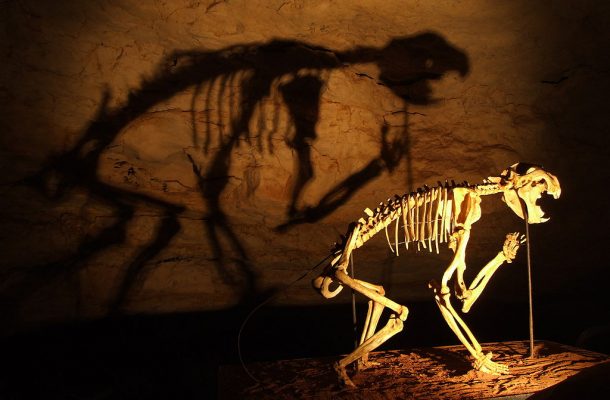Did climate change wipe out the Australian lion?

The extinction of one of Australia’s top predators, Thylacoleo carnifex – aka the marsupial lion – was likely a result of changing weather patterns and loss of habitat rather than human impacts, new research has found.
Palaeontologists from UNSW Sydney, University of Queensland and Vanderbilt University (Tennessee) addressed the question about the demise of the marsupial lion by looking into the powerful carnivore’s chemistry.
By studying the chemical signature preserved within fossil teeth, the team was able to determine that the marsupial lion hunted primarily in forests, rather than open habitats. This is supported by features of the skeleton that indicate it was an ambush hunter, relying on catching its prey unaware rather than running them down across an open landscape.
For nearly two million years the marsupial lion was one of Australia’s top predators. The animals were sized between leopards and African lionesses but had a bite that was about 80 per cent as strong as a large lion, enabling it to crush bones with its powerful jaws.
The study led by Professor Larisa DeSantis of Vanderbilt University posited that, despite being well-adapted for consuming flesh and bone, Thylacoleo was likely the victim of the drying out of Australia, which began about 350,000 years ago.
The marsupial lions persisted for thousands of years afterwards, as more and more forests disappeared. The animals survived even past the influx of humans to the continent roughly 60,000 years ago. Ultimately, the loss of forest habitats likely led to the extinction of these predators, with the last known record sometime between approximately 35 and 45 thousand years ago.
“These data provide evidence that the marsupial lion was an ambush predator and relied on prey that occupied denser cover,” Professor DeSantis said.
“As the landscape became drier and forests less-dense, these apex predators may have become less-effective hunters and succumbed to extinction.
“The study of these ancient fossils provides us with cautionary lessons for the future: climate change can impact even the fiercest predators.”
The marsupial lion lived alongside the Thylacine, which survived until the 20th century. The preference of the Thylacine for prey from more open habitats likely led to its survival, despite having a much weaker bite than Thylacoleo carniflex.
Professor Michael Archer, a vertebrate palaeontologist at the University of New South Wales and one of the researchers involved said that because of its extraordinarily specialised dentition, Thylacoleo carnifex has been declared to be the most specialised mammalian carnivore that ever evolved anywhere in the world.
“Marsupial lions were far more specialised than African lions. They even had a proportionately larger brain than African lions as well as large, uniquely formidable, large can-opener-like thumb claws,” Professor Archer said.
“What’s increasingly clear now is that it evidently survived the arrival of humans 60,000 years ago, but apparently not the profound impacts of a rapidly drying climate that undermined the survival of a range of megafaunal mammals in Australia.”
According to Professor Archer, Thylacoleo carnifex was the last representative of this extraordinary group of flesh-eating marsupials. He said it was the largest of many kinds documented by Dr Anna Gillespie of UNSW, on the basis of the 25 million-year-long fossil record from the Riversleigh World Heritage Area in Queensland.
This record includes pussy-cat-sized marsupial carnivores like Microleo attenboroughi and leopard-sized species like Wakaleo schouteni.
Study co-author Gilbert Price of the University of Queensland said: “When you’re big and bitey, you can eat pretty much anything you want. But our findings show that even the top predators are no match for extreme climate change.”
Open Forum is a policy discussion website produced by Global Access Partners – Australia’s Institute for Active Policy. We welcome contributions and invite you to submit a blog to the editor and follow us on Twitter, Facebook, Linkedin and Mastadon.














Amelia Anderson
October 21, 2018 at 8:16 am
I find it hard to believe that humans didn’t play a major role in their disappearance, alongside the rest of the Australian megafauna. Mankind wiped out innumerable species in every other continent when we moved out of Africa after the last ice age, and aborigines would not only have hunted the animal themselves but competed with it for cave shelters. Aborigines also systematically burned large tracts of forest to kill animals or make it easier to hunt them, destroying the lions habit and food sources. If people had never come to this continent the marsupial lion, and a hundred other species, would still be around.
Max Thomas
October 23, 2018 at 8:34 am
Heresy Amelia. Tut, tut. 🙂